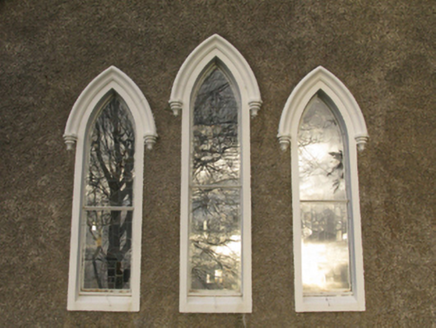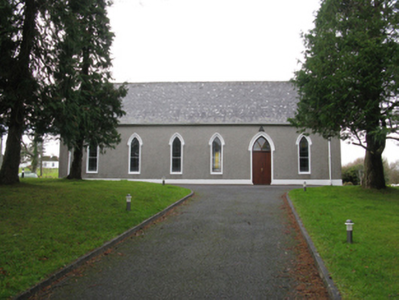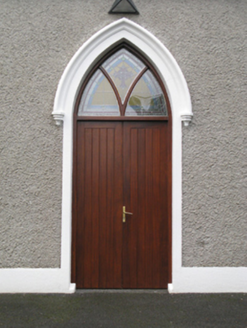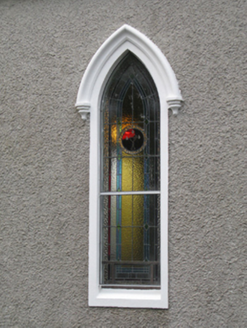Survey Data
Reg No
31305801
Rating
Regional
Categories of Special Interest
Architectural, Artistic, Historical, Social, Technical
Original Use
Church/chapel
In Use As
Church/chapel
Date
1835 - 1840
Coordinates
105350, 299823
Date Recorded
25/11/2010
Date Updated
--/--/--
Description
Detached six-bay double-height single-cell Catholic church, built 1838, on a rectangular plan. Renovated, ----, with sanctuary reordered. Pitched slate roof with clay ridge tiles, and replacement uPVC rainwater goods on eaves boards retaining cast-iron downpipes. Roughcast walls on rendered plinth. Lancet window openings, rendered surrounds with hood mouldings on ogee-detailed labels stops framing storm glazing over fixed-pane fittings having stained glass margins centred on stained glass roundels. Lancet "Trinity Window" (west), rendered surrounds with hood mouldings on ogee-detailed label stops framing storm glazing over fixed-pane fittings having leaded stained glass panels. Full-height interior open into roof with cruciform-detailed drag edged dragged cut-limestone baptismal font on an octagonal plan (east), carpeted central aisle between cruciform-detailed timber pews, stations between stained glass windows, carpeted stepped dais to sanctuary (west) reordered, ----, with replacement timber altar below stained glass "Trinity Window" (----), and exposed arch braced strutted collared timber roof construction on thumbnail beaded corbels with wind braced ceiling. Set in landscaped grounds with repointed sandstone ashlar piers to perimeter having lichen-covered cut-limestone shallow pyramidal capping supporting flat iron double gates.
Appraisal
A church erected under the aegis of Reverend John Hopkins PP (fl. 1837-9) representing an important component of the early nineteenth-century ecclesiastical heritage of County Mayo with the architectural value of the composition, one showing the hallmarks of a period of construction in the immediate aftermath of the Roman Catholic Relief Act, 1829, suggested by such attributes as the rectilinear "barn" plan form, aligned along an inverted liturgically-correct axis; and the slender profile of the openings underpinning a "medieval" Georgian Gothic theme with the chancel defined by an elegant "Trinity Window". Having been well maintained, the elementary form and massing survive intact together with quantities of the historic fabric, both to the exterior and to the restrained interior reordered (----) in accordance with the liturgical reforms sanctioned by the Second Ecumenical Council of the Vatican (1962-5) where an exposed timber roof construction pinpoints the engineering or technical dexterity of a church making a pleasing visual statement in a sylvan setting.







